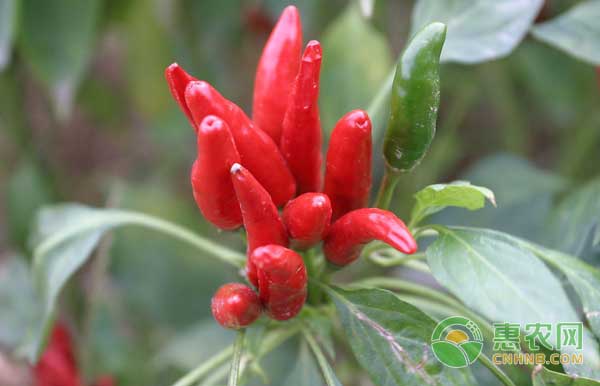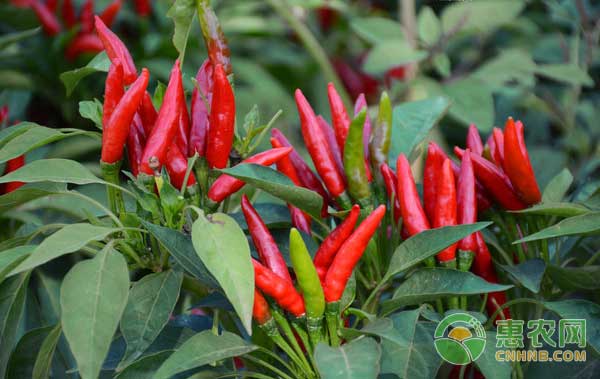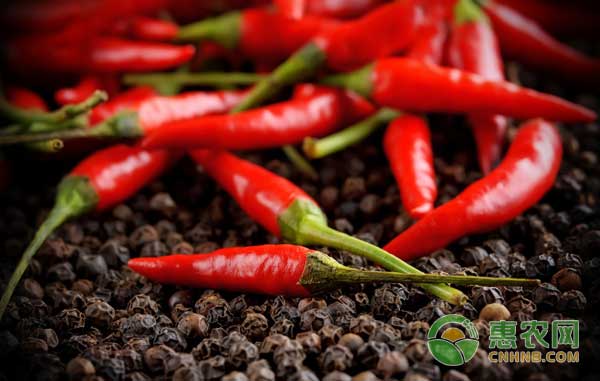The improvement of people's living standards and the awareness of food safety have also increased. In order to meet the needs of consumers, farmers can develop organic vegetable cultivation and create better economic benefits. The following is a high-yield cultivation technique for organic peppers. First, sowing seedlings 1. Cultivation season Cultivation of peppers in the Yangtze River basin in winter and spring, planting in early October to early November, planting from mid-February to early March; cultivation in spring dew, planting from late October to mid-November, transplanting from late March to early April Summer dew cultivation, planting in early June, transplanting in early July; cultivation in autumn dew, planting in early July, transplanting in early August; cultivation in greenhouse after autumn extension, sowing in mid-July, and transplanting in mid-August. 2, substrate selection Use special organic seedling substrate, or use high temperature sterilization of matrix materials, according to the ratio of peat: perlite: organic fertilizer = 7:2:1, according to the source of grass charcoal and seasonal changes to make appropriate adjustments. 3, seed treatment There are two ways to plant and disinfect. One is the soaking of the medicament. After soaking for 15 minutes with 1% potassium permanganate solution, the seeds were washed repeatedly with water, and then soaked to eliminate the belt virus. In areas where anthrax and scab are serious, you can soak them in water for 6-15 hours, then soak them in 1% copper sulfate for 5 minutes, rinse them repeatedly with water or add a small amount of ash or hydrated lime (calcium hydroxide) to neutralize the acidity. Then germination sowing. The second is the soaking of warm soup. Immerse the seeds in constant temperature water at 55 ° C and keep stirring. When the water temperature drops to 30 ° C, stop stirring, soak for 8-12 hours, and then germination. Can alleviate the occurrence of various diseases. 4, plug seedlings The use of plastic greenhouses, greenhouses and other nursery facilities, covered with sunshade nets in summer, insulation measures in winter, using seedlings for seedlings. After the end of each nursery, disinfection of the facilities such as seedbeds and trays is carried out. 5, strong seedling standards Winter and spring seedlings, plant height 12-15 cm, diameter 0.4 m or more, cotyledons intact, 5-6 true leaves, leaf color green, no pests and diseases. Second, the soil preparation The base fertilizer is fully fermented with homemade organic fertilizer, mushroom residue: chicken manure: vegetable waste = 1:4:2, 3000 kg per acre, combined with ploughing and full tillage layer for full fertilization. Or 2500 kg of fermented organic fertilizer per mu (or 100-130 kg of decomposed soybean cake fertilizer, or 150 kg of decomposed peanut cake fertilizer), 40 kg of phosphate rock powder and 20 kg of potassium ore powder. The soil is deeply ploughed 20-30 cm, and the soil is tidy, fine, ditched, and simmered, and the ridge is 1.2 m wide. Third, timely planting According to the cultivation season, it is planted in time, generally 2 rows per plant, and the plant spacing is 35-40 cm. Choose a sunny, warm and windless weather for colonization. The depth of colonization is preferably the same as that of the cotyledons. The hole in the mulch hole should be sealed. After the planting in winter and spring, take a small arch shed in time and cover the film. Fourth, field management 1, temperature management In the slow seedling stage within one week after planting, the enclosure is insulated. Afterwards, the weather will gradually ventilate to make the plants grow stronger. Ventilation and ventilation can be performed by using the closing time of the shed door to adjust the temperature and humidity. 2, lighting management In combination with the adjustment of environmental conditions such as temperature and humidity, the lighting conditions are adjusted overall, and the film surface is kept clean in winter and spring, and the insulation cover is uncovered during the day to maximize the light intensity and time. Appropriate shading and cooling in summer and autumn. 3. Fertilizer management Generally, potassium sulphate and magnesium fertilizer are used for topdressing. 15 kg of potassium sulphate and magnesium fertilizer per acre is used to dissolve in water and applied with irrigation system; field water management depends on seedling condition, generally after planting, a slow seedling water is poured. When the pepper grows to 6-7 cm, it is removed to keep the soil moist and prevent premature aging. During the fruiting period, water is watered every 7 days in fine weather, and each time it is watered to 15 cm below the soil surface. And in the after-fertilization irrigation, timely ventilation and ventilation, reduce the air humidity in the shed, and after each harvest, topdressing once. 4, plant regulation Before the first plant inflorescence is 18-20 cm high, the bamboo shoots with a height of about 45 cm are inserted into the rhizosphere soil near the main stem of the plant. The lower part of each ear is tied with a soft string and the ears are sorted in time. Generally, the single-stalk pruning is carried out, and the side branches within 20 cm from the ground are removed, and the old leaves, yellow leaves and diseased leaves of the base are removed at the appropriate time. 5. Prevention and control of pests and diseases 1, blight Before the onset or at the beginning of the disease, spray with 77% copper hydroxide wettable powder 500 times, spray once every 7-10 days, even spray 2-3 times. 2, gray mold Sprayed with a 300-fold solution of Bacillus subtilis (leaf type) wettable powder. Or control with 300 times liquid spray of Trichoderma harzianum (leaf type). 3, scab disease At the beginning of the disease, 800 times of potassium permanganate aqueous solution was sprayed and used once every 7-10 days for 2-3 times. Or use 77% copper hydroxide wettable powder 500 times liquid spray control, can cure soft rot, scab, leaf spot and bacterial wilt. 4, the disease Before the onset, 1.5-2.5 kg of copper sulfate crystals were added per acre with irrigation. In the early stage of the disease, 0.1% potassium permanganate and 0.2% wood vinegar were sprayed, and the drug was sprayed once every 7-10 days. 5, anthracnose Before the onset or at the onset of the disease, spray with 77% copper hydroxide wettable powder 500 times, spray once every 7-10 days, continuously spray 2-3 times, and stop 7 days before the vegetables are received. Or spray with 1:1:200 times Bordeaux mixture or copper sulfate 200 times, use once every 7 days, even spray 2-3 times. Or spray with 500 times sodium bicarbonate solution every 3 days, even spray 5-6 times. 6, bacterial wilt Before the onset or at the beginning of the disease, spray with 77% copper hydroxide wettable powder 500 times, spray once every 7-10 days, even spray 2-3 times. Or rooting with 600 times liquid of Bacillus subtilis (root type), pouring water to the base of the stem, each plant needs to be watered 150 ml. Or 0.5g of Bacillus polymyxa per square meter in the seedbed, poured with water, or 200g of 100 million original powder of Bacillus polymyxa per acre after planting, diluted with water and then rooted, used in the whole growth period 3- 4 times, respectively, in sowing (soaking and pouring), false planting, transplanting and planting or initial disease, pouring or rooting, the cumulative dose is generally about 1000 grams per acre. 7, blight Spray with 0.3% eugenol soluble solution 1000-1500 times solution. Or when the pepper seedlings are planted, 200 g of Trichoderma harzianum is used per mu, and then mixed with 1.25 kg of rice bran, and the roots of the seedlings are stained with fungus and then planted. Or when the field is initially ill, roots are filled with 600 times solution of Trichoderma harzianum. 8, cotton bollworm Spraying with 16000 units of Bacillus thuringiensis wettable powder 500 times solution, or spraying with cotton bollworm nuclear polyhedrosis virus and Bacillus thuringiensis is effective. Apply the cotton bollworm eggs at the peak of hatching, and spray with 0.5% cucurbitacin soluble liquid 800-1000 times. In the young larval stage, spray 5%-step pyrethrin emulsifier 1500-2000 times. 9. Pests such as aphids, cabbage moths, and Spodoptera litura In the initial stage of pest damage, spray evenly with 2.5% rotenone emulsifiable concentrate 400-500 times solution or 7.5% rotenone emulsifiable concentrate 1500 times solution. Or pre-prevention with 0.3% Kushen water reducing agent 600-800 times liquid spray, the insects are sprayed with 0.3% matrine water agent 400-600 times liquid, and sprayed once every 5-7 days. In the peak period of insect pests, the dose can be increased appropriately. Spray once every 3-5 days for 2-3 times. When spraying, spray the leaves and leaves evenly, especially the leaf back. 10. Prevention and control of underground pests It can control adults and larvae of the golden tortoises such as the golden tortoise, the dark black tortoise, the patina, and the four-spotted tortoise. It can be used alone or in combination with other pesticides. When using the fungus of Beauveria bassiana (10 billion original powder) alone, the dosage per acre is 500-1000 grams. Sixth, timely harvest High temperature should be avoided during picking, before 9 am in summer or after 3 pm in summer; mature fruits should be harvested in time. Stop watering 5-7 days before harvesting; hold the fruit along the separation layer to prevent the mechanical damage, and enter the grading and packaging workshop in time. Seven, transportation and storage Peppers sold to distant cities should be selected into cartons after harvesting, and pre-cooled for 8-12 hours in a cold storage at 8-10 ° C and relative humidity of 85%-90% before being transported. It is best to use insulated trucks for transportation. There is no ordinary truck + quilt, or truck + quilt + ice for transport. Before entering the supermarket, use a small package such as a tray or a portable film bag or paper bag to enter the supermarket counter. The temperature of the cold storage is controlled at 10 °C. If mixed with other cold-tolerant vegetables, the temperature of the cold storage should be controlled at 5 °C. Supermarket sales of freezer temperature control at 5-10 °C. The sales counter at room temperature should be placed less and the counter should be replenished from the cold storage at any time. The above is the high-yield cultivation technology of organic peppers, I hope to help you! Organic peppers are more expensive than ordinary peppers, and the development of organic peppers is more efficient. Active Ingredient,Main Component,Flavone,Saponins Shaanxi Zhongyi Kangjian Biotechnology Co.,Ltd , https://www.zhongyibiotech.com


How is organic pepper grown? High-yield cultivation techniques of organic pepper
Next Article
Kiwi Spring Management seizes these points